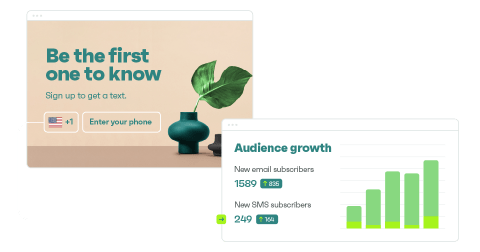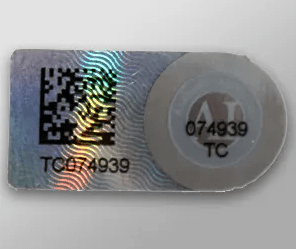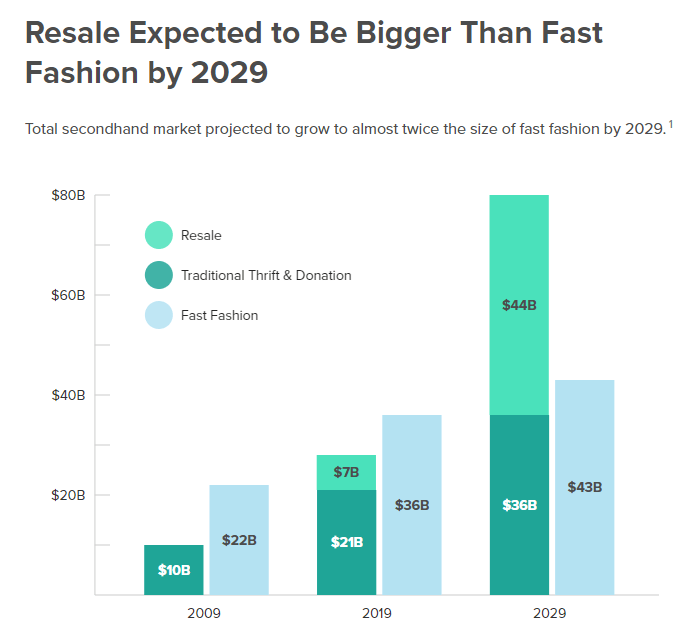The next REAL ITEMS verified are KN95 masks from Tricol Group. Capacity to make 200,000+ masks per day, All orders made through https://t.co/5PFrDDObQ6 and our partners will have a #VeChain NFT for product authenticity on each box. #coronavirus #KN95 #kn95mask #cdctips pic.twitter.com/HRUxJ8BEJW
— Real Items Ⓥ (@itemsdapp) April 3, 2020
Drive sales on autopilot with ecommerce-focused features
See FeaturesHow NFTs can fight fraud and increase customer loyalty
NFTs, or non-fungible tokens, have garnered a lot of attention this year. With the NFT artwork Everydays: The First 5000 Days selling on legendary auctioneer Christie’s for nearly $70 million, NFTs have caused a great amount of awe, shock, and skepticism.
Is it all just a fad, a quick buck for snake oil salesmen?
Not at all, says David Menard, CEO and Founder of RealItems.io, a company that uses VeChain-powered NFTs to fight fraud. In fact, Menard tells Omnisend that NFTs are a vehicle that can be used to not only verify the authenticity of ecommerce products and improve the user experience, but also bring about a renaissance to the commerce world.
“NFTs are unique in a digital world”
For Menard, getting people to even understand the basic gist of what an NFT is can be a big challenge.
When asked to explain it in its simplest terms, Menard tells Omnisend: “An NFT is more of a vehicle of information that is unique like a snowflake.”
“Whereas before we were used to JPEGs and PNGs that can be copied and shared amongst friends and family, an NFT is a type of digital content that is digitally quantifiable.” This means that, instead of having a copy of a JPEG that is an exact duplicate of another JPEG, you’d have a unique version of that JPEG—or book, or music, or physical product.
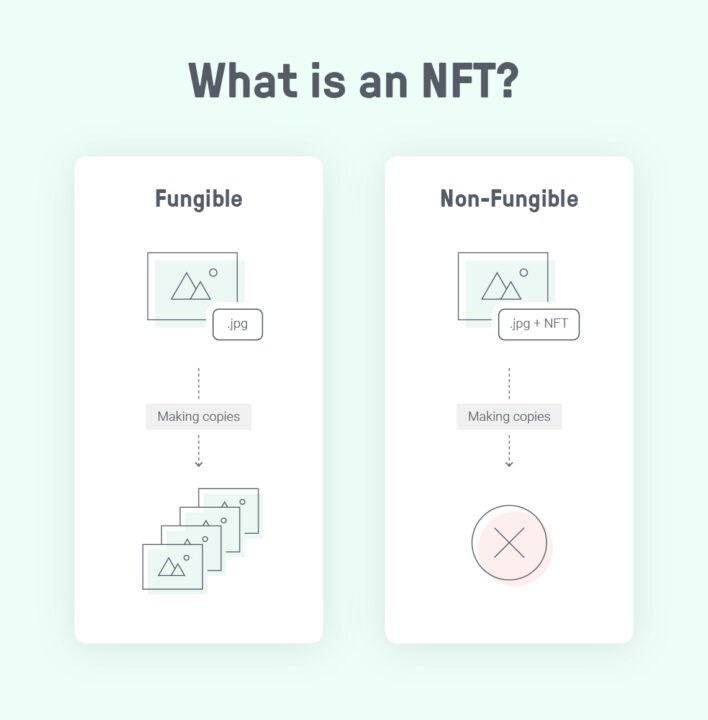
This uniqueness, he believes, is both the core strength of NFTs and also the hardest for people to wrap their heads around.
“That point of uniqueness in a digital world is probably the hardest for people to accept because nothing in our common understanding of digital is unique. Everything is just a copy of something.”
But to really understand NFTs, it’s also important to understand how it works with other systems within the blockchain ecosystem. Here’s where the ideas of decentralization and trustless comes into play.
All the systems that we are familiar with, are centralized—whether that’s the government, the banks, or various other institutions. These organizations are at the center of the data collection, data storing, and data communication, and at some level we are forced to trust that these institutions are providing us with accurate information.
Currently, however, we’re seeing the emergence of a decentralized, trustless system. Trustless here doesn’t refer to a lack of trust in the system. Instead, it’s more a system that requires no assumed trust into any institution. The trust is, instead, based on proof of authenticity that by design cannot be tampered with.
“So an NFT,” Menard explains, “is more like a timestamp in the trustless system that everyone is now starting to use to then be able to say: ‘this is the data that I trust.’ Because now, in order to even get into the system, there are checks and balances, and then once in the system there’s no editing so everything can be accountable to the same terms.”
How NFTs can work with sneakers: an example
Let’s say that we have a sneaker shop and we wanted to use NFTs to verify our products.
Firstly, we’d use something like Real Items to serialize the sneakers, which means that a unique ID would be generated for each pair of shoes. “That serialized identity would then be embedded into the physical product with the agnostic sensor [a sensor that can work with a variety of scanners or hardware],” Menard tells Omnisend.
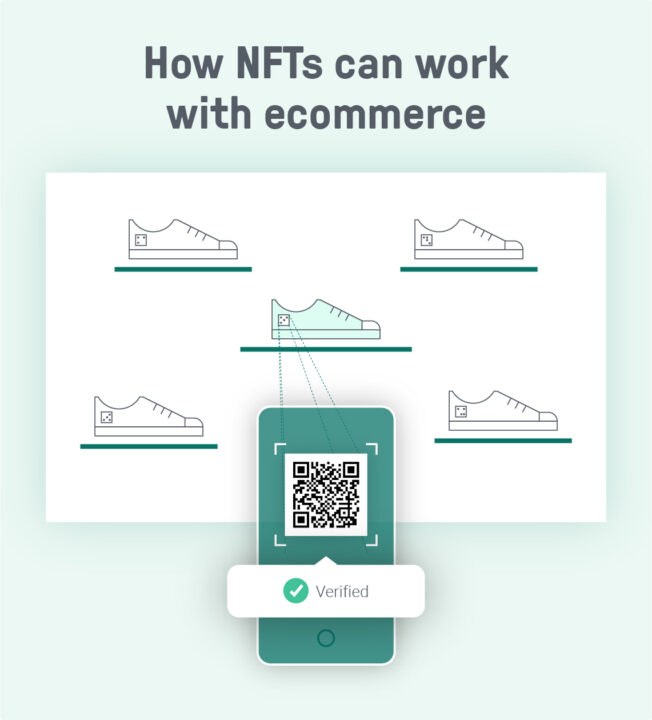
This type of sensor would not give off an active signal (like an ankle monitor), but rather a passive way for companies and consumers to scan and prove the sneakers’ authenticity. “What we’re doing is giving [the sneakers] more of a digital certificate of authenticity that can be passed alongside with the shoe and verified by scanning the shoe.”
In practice, a consumer can purchase a pair of sneakers from a Shopify store and receive the NFT via email or into their Real Items wallet.
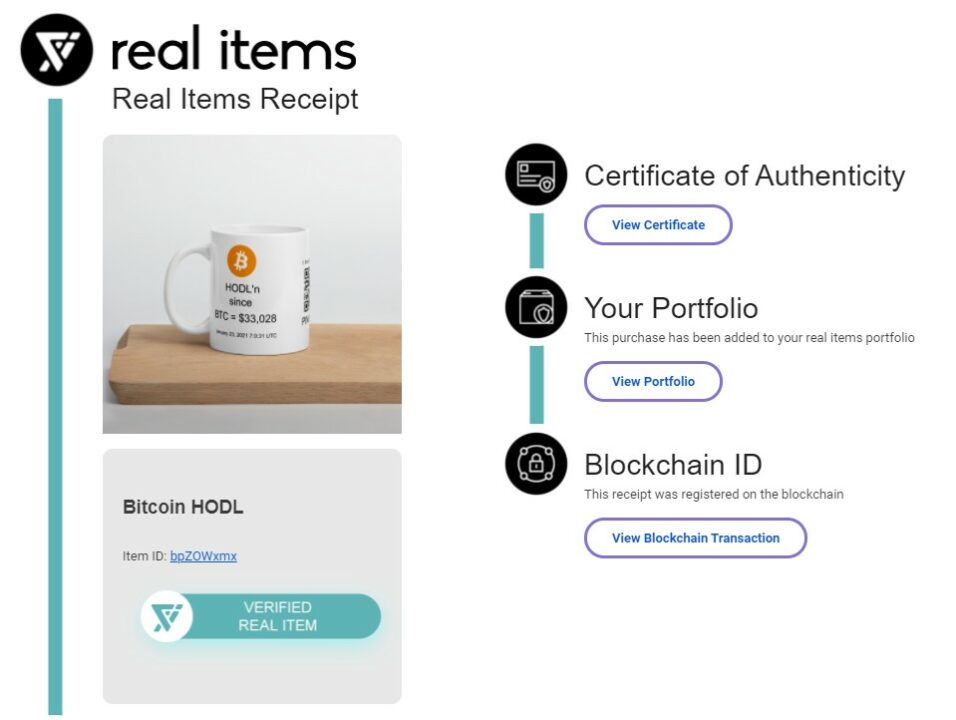
When they get the physical product, they can scan the QR code to verify that the item is authentic—matching the receipt and the record on the blockchain. Depending on what kind of information the store makes available, the customer would also be able to see other information for those sneakers—where the materials were sourced, manufactured, handled, shipped, etc.
This can be a crucial proof of authenticity for brands, such as jewelry or chocolate companies, that have built sustainability and ethical sourcing into the core of their products and their brand identity.
Not only would the brands’ promotional materials communicate this information to their customers, but those customers would then also be able to see for themselves how those products are made. In fact, they’d be able to see the exact journey that particular, granular product took before it ended up in their hands.
The connection and trust from that kind of knowledge can really strengthen brand loyalty.
The move to “phygital”
Because of the way that NFTs work, they have numerous use cases for ecommerce stores, including anti-fraud, loss prevention, quality assurance, and even customer loyalty and rewards.
Menard tells Omnisend that in order for ecommerce stores, such as their Shopify clients, to use NFTs, they would need to create what he calls “phygital” products—products that are physical with a digital identity.
Essentially, for every physical product, a unique NFT is created to provide authenticity and verification—crucial elements in a world where counterfeit products are running rampant.
NFTs and ecommerce: a fight against fraud
According to various sources, global counterfeit goods account for anywhere from $500 billion to $1.8 trillion. The trade in counterfeit fake goods is estimated to be 2.5% of world trade—and rising.
Footwear and clothing are the industries most affected by fake goods. In fact, Nike ended its partnership with Amazon in 2019 after two years due to the massive amount of fake Nike goods sold on the platform.
For the most part, consumers are not aware that they are purchasing fake goods from online stores, even after they receive the products.
Brands have attempted many ways to authenticate their products in order to solve this problem. One well-known example of this is the NFL’s use of hologram stickers (“holotags”) so that customers can verify that the products are real.
Real Items hopes to solve this problem in a more practical sense, for more businesses.
The company had recent experience with helping to secure the supply chain of a Chinese respiratory mask manufacturer. In April 2020, Illinois’ department of health lamented that fake KN95 masks were flooding the marketplace, and they recommended discontinuing the use of those masks until “their authenticity and performance (through fit testing) can be verified.”
To help, Real Items used their NFT system to help verify up to 200,000 KN95 masks per day to help fight against counterfeit—and therefore dangerous—masks.
This can also work against loss prevention for larger stores. “NFTs provide serialization of products which allows retailers and distributors to know inventory on a granular level,” Menard says. With better monitoring, there will be fewer gaps in the process for bad actors to exploit and steal inventory.
Real Items are currently working on combining traditional RFID technology, required by big box stores to trigger alarms, with NFTs to combine anti-counterfeit and loss prevention technology.
How NFTs can impact customer reward and loyalty strategies
Menard sees NFTs helping ecommerce businesses with more than anti-fraud and loss prevention.
Because the product has a unique ID, and that ID is connected to the customer (via their email or their Real Items wallet), brands can send rewards instantly to customers.
“We can airdrop USDC stablecoin [cryptocurrency that’s pegged in value to the US dollar] after scanning and verifying something. So now, instead of just getting Chuck E. Cheese points to use in your store as a rebate, I literally just gave you digital currency.”
For marketers, this can open up a whole host of opportunities. Brands can initiate various customer loyalty and rewards programs based specifically on what customers are doing with those products. This includes things like gamification, moving customers through the customer lifecycle, offering free products, and even rewarding customers with digital goods.
Let’s say a user buys a recurring, replenishable product, something like shampoo. If they buy five, they can unlock a special BOGO offer, or get the sixth free. After one year of consistent recurring purchases, they can unlock even bigger rewards. Because NFTs are digitally quantifiable, they can be used as verifiable points for consumers to earn additional rewards.
Integrating NFTs into stores
For the most part, existing customers don’t need extra hardware in order to use NFTs in their system. Instead, different types of businesses can use different versions of the system, depending on their needs.
When working with different brands, Real Items asks: “What’s your price point? What type of product does this need to be—a printing solution? Do we need to step up to NFC? RFID? We can have digital wallets embedded with little chips on each product, but it really depends on the price point and the interest.”
Real Items even has more advanced applications, including what it calls “The Sentinel”—an Android app that can be mounted anywhere on the assembly line and used to check in certain products, even in high-speed and high-volume environments.
This would also allow a variety of business insights and operational improvements to the anti-fraud departments that would be able to proactively gather intel and settle disputes. That way, brands can uphold the MSRP value of the products that various outlets are authorized to sell.
The push towards a circular economy
Menard sees the introduction of NFTs and the blockchain in general as allowing greater opportunities for us to move from a linear economy to a circular economy.
Linear economies—the ones we’re most used to—are those economies that follow the “take-make-waste” model. Resources are taken, products are made, and when the products have reached the end of their usefulness, they are sent to some landfill.
A circular economy is designed to be regenerative, so that products are used and reused. In this way, “growth” is separated by the consumption of finite resources. NFTs can be the vehicle to get us there.
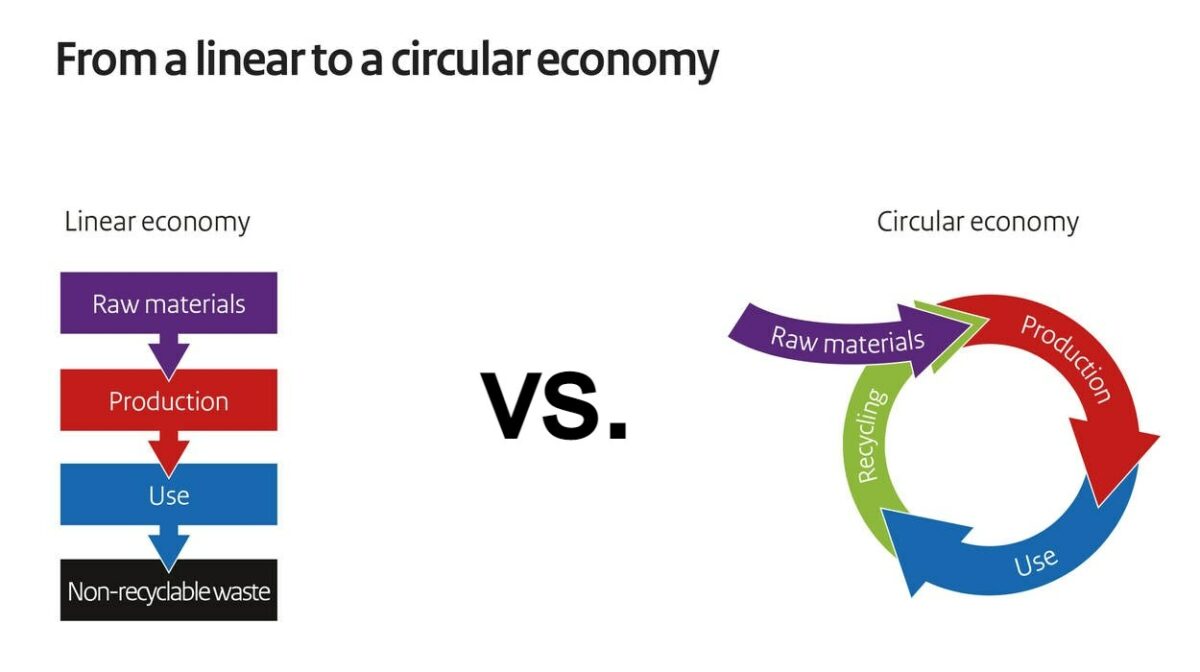
“For us, the NFT is the vehicle that not only protects the origin, it also optimizes the waste management towards the end of its product lifecycle. So having this be digitally quantifiable, even from from a garment standpoint, where fast fashion—you know, where we really could see that for every garment we’re producing we’re able to track it and put it back into the system in some way and then use it as a resource for another type of energy.”
This ability to accurately track an item from its creation to the end of its lifecycle can give great insights into the product, its usage and its eventual re-usage in a circular economy.
Already, we’re seeing the initial stages of the circular economy with companies such as Vinted tapping into the used clothing market. In fact, it is estimated that by 2029 the total secondhand market will be nearly twice as large as the fast fashion industry.
For the most part, consumers are also eager for better practices. A report by IBM showed that 60% of consumers are willing to change their shopping behavior to reduce their environmental impact, while 80% indicated that sustainability was important to them.
The future of NFTs in ecommerce and the “metassance”
Menard envisions a future in which NFTs are not only an integral part of ecommerce, but rather an integral part of our future digital lives.
This is because of the way that NFTs work. Instead of NFTs being a “system,” Menard and Real Items view NFTs as a vehicle to have unchangeable, accurate information built within a trustless, decentralized system.
“As a child you get Legos and you dump them out and you think: what can I build? And…when I go into my meetings it’s like okay…we can get into rabbit holes. But let’s just throw stuff on the table like Legos and build stuff and think through them to see which one is the best direction that we’d want to go.”
This makes NFTs widely applicable in many verticals. “There are just so many different variations, and it’s really just the mindset of the company to be willing to want to do more.”
At the moment, though, Menard sees NFTs and the “digital art” craze as being a bump in the road. He views NFT marketplaces like OpenSea as “the next great Pacific garbage patch. It has a bunch of litter, it’s got a bunch of other people’s IP [intellectual property] that they’re not taking responsibility for [how it got] there.”
He sees this as a problem of NFTs enabling versus protecting. In the current NFT craze, platforms are enabling people, without the proper checks and balances, to engage in theft and speculation.
“For Real Items,” Menard says, “we’ve gone slower because we really focused on protection…a genuinely basic common sense of ‘I need to verify something’ or ‘I need to have some knowledge when people are actively not trying to give me knowledge or give me transparency or the perspective to make the best decision.’”
But the current landscape is only the growing pains of a new, paradigm-shifting technology.
“What people don’t realize is that it’s more than a revolution, it’s more than just a renaissance for art. It’s the metassance, it’s absolutely everything becoming a real item and verifiable.”
quick links
related features
No fluff, no spam, no corporate filler. Just a friendly letter, twice a month.

